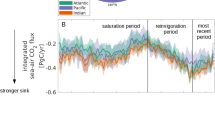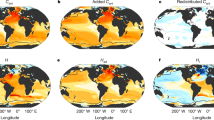Abstract
In global climate model pre-industrial control simulations the Southern Hemisphere westerly winds show a systematic bias in position and strength relative to estimates of their actual position and strength. These wind-stress biases impact the simulated transport of the Antarctic Circumpolar Current1 and the nature of Southern Ocean water-mass formation1 and may affect the rate of meridional overturning of the global ocean2. The effect they have on oceanic carbon uptake and storage is unknown, however. Here we demonstrate, using a coupled carbon–climate model3, that the wind-stress biases reduce equilibrium ocean carbon storage, redistribute carbon within the ocean and increase oceanic carbon uptake in climate change simulations. The wind-stress biases act directly by influencing Ekman pumping dynamics in the Southern Ocean and also seem to have an indirect effect on the overturning circulation and carbon distribution through the Agulhas leakage and Indo–Atlantic salt flux. Our results indicate that carbon–climate model simulations with the typical pre-industrial wind-stress bias will over-estimate ocean carbon sequestration, and thereby under-estimate atmospheric carbon dioxide concentrations in the twenty-first century, relative to unbiased simulations. The new generation of coupled carbon–climate models may be subject to these wind biases, which could alter their carbon–climate response, although it is worth noting that the uncertainty arising from wind biases that we demonstrate here is one of several uncertainties that affect modelled ocean carbon uptake4.
This is a preview of subscription content, access via your institution
Access options
Subscribe to this journal
Receive 12 print issues and online access
$209.00 per year
only $17.42 per issue
Buy this article
- Purchase on Springer Link
- Instant access to full article PDF
Prices may be subject to local taxes which are calculated during checkout




Similar content being viewed by others
References
Russell, J., Stouffer, R. J. & Dixon, K. Intercomparison of the Southern Ocean circulations in IPCC coupled model control simulations. J. Clim. 19, 4560–4575 (2006).
Sijp, W. & England, M. The effect of a northward shift in the Southern Hemisphere westerlies on the global ocean. Prog. Oceanogr. 79, 1–19 (2008).
Weaver, A. et al. The UVic Earth System Climate Model: Model description, climatology, and applications to past, present and future climates. Atmos. Ocean 39, 1–68 (2001).
Friedlingstein, P. et al. Climate–carbon cycle feedback analysis: Results from the C4MIP model intercomparison. J. Clim. 19, 3337–3353 (2006).
Meredith, M., Naveira Garabato, A., Hogg, A. M. & Farneti, R. Sensitivity of the overturning circulation in the Southern Ocean to decadal changes in wind forcing. J. Clim. (in the press).
Fyfe, J. & Saenko, O. Simulated changes in the extratropical Southern Hemisphere winds and currents. Geophys. Res. Lett. 33, L06701 (2006).
Russell, J., Dixon, K., Gnanadesikan, A., Stouffer, R. & Toggweiler, J. The Southern Hemisphere Westerlies in a warming world: Propping open the door to the deep ocean. J. Clim. 19, 6382–6390 (2006).
Eby, M. et al. Lifetime of anthropogenic climate change: Millennial time scales of potential CO2 and surface temperature perturbations. J. Clim. 22, 2501–2511 (2009).
Meehl, G. A. et al. The WCRP CMIP3 multi-model dataset: A new era in climate change research. Bull. Am. Meteorol. Soc. 88, 1383–1394 (2007).
Hibbard, K., Meehl, G. A., Cox, P. M. & Friedlingstein, P. A strategy for climate change stabilization experiments. Eos 88, 217–221 (2007).
Beal, L. et al. On the role of the Agulhas system in ocean circulation and climate. Nature 472, 429–436 (2011).
Peeters, F. et al. Vigorous exchange between the Indian and Atlantic oceans at the end of the past five glacial periods. Nature 430, 661–665 (2004).
Biastoch, A., Boning, C. W., Schwarzkopf, F. U. & Lutjeharms, J. R. E. Increase in Agulhas leakage due to poleward shift of Southern Hemisphere westerlies. Nature 462, 495–498 (2009).
Weijer, W., de Ruijter, W., Dijkstra, H. & van Leeuwen, P. Impact of interbasin exchange on the Atlantic overturning circulation. J. Phys. Oceanogr. 29, 2266–2284 (1999).
Biastoch, A., Boning, C. W. & Lutjeharms, J. R. E. Agulhas leakage dynamics affects decadal variability in Atlantic overturning circulation. Nature 456, 489–492 (2008).
Sijp, W. & England, M. Southern Hemisphere westerly wind control over the ocean’s thermohaline circulation. J. Clim. 22, 1277–1286 (2009).
Meehl, G. A. et al. in IPCC Climate Change 2007: The Physical Science Basis (eds Solomon, S. et al.) 747–845 (Cambridge Univ. Press, 2007).
Zickfeld, K., Fyfe, J., Saenko, O., Eby, M. & Weaver, A. Response of the global carbon cycle to human-induced changes in Southern Hemisphere winds. Geophys. Res. Lett. 34, L12712 (2007).
Kidston, J. & Gerber, E. Intermodel variability of the poleward shift of the austral jet stream in the CMIP3 integrations linked to biases in 20th century climatology. Geophys. Res. Lett. 37, L09708 (2010).
Compo, G. P. et al. The twentieth century reanalysis project. Q. J. R. Meteorol. Soc. 137, 1–28 (2011).
Kushner, P., Held, I. & Delworth, T. Southern Hemisphere atmospheric circulation response to global warming. J. Clim. 14, 2238–2249 (2001).
Pacanowski, R. Mom 2 Documentation, User’s Guide and Reference Manual GFDL Ocean group Tech. Rep. 3 (NOAA/GFDL, 1995).
Bryan, K. & Lewis, L. A water mass model of the world ocean. J. Geophys. Res. 84, 2503–2517 (1979).
Gent, P. & McWilliams, J. Isopycnal mixing in ocean circulation models. J. Phys. Oceanogr. 20, 150–155 (1990).
Schmittner, A., Oschlies, A., Giraud, X., Eby, M. & Simmons, H. L. A global model of the marine ecosystem for long-term simulations: Sensitivity to ocean mixing, buoyancy forcing, particle sinking, and dissolved organic matter cycling. Glob. Biogeochem. Cycles 19, GB3004 (2005).
Meissner, K. J., Weaver, A. J., Matthews, H. D. & Cox, P. M. The role of land surface dynamics in glacial inception: A study with the UVic Earth System Model. Clim. Dyn. 21, 515–537 (2003).
Weber, S. L. et al. The modern and glacial overturning circulation in the Atlantic ocean in PMIP coupled model simulations. Clim. Past 3, 51–64 (2007).
Acknowledgements
N.C.S. received financial support from the National Research Foundation of South Africa, and through the NSERC CREATE training programme in interdisciplinary climate science at the University of Victoria, Canada. We thank the UVic Climate Modelling Group, in particular M. Eby, A. Weaver and E. Wiebe, for help with the UVic ESCM. This research has been enabled by the use of computing resources provided by WestGrid and Compute/Calcul Canada. We acknowledge the modelling groups, the Program for Climate Model Diagnosis and Intercomparison and the WCRP’s Working Group on Coupled Modelling for their roles in making available the WCRP CMIP3 multi-model data set. Support of this data set is provided by the Office of Science, US Department of Energy. J. Christian, M. Eby, N. Gillet and J. Scinocca provided useful comments on an early draft of the manuscript.
Author information
Authors and Affiliations
Contributions
J.C.F. conceived of the experiment, advised on the analysis, helped to interpret the results and edited the paper. N.C.S. designed the experiment, conducted the model runs, analysed the output, interpreted the results and wrote most of the paper.
Corresponding author
Ethics declarations
Competing interests
The authors declare no competing financial interests.
Supplementary information
Rights and permissions
About this article
Cite this article
Swart, N., Fyfe, J. Ocean carbon uptake and storage influenced by wind bias in global climate models. Nature Clim Change 2, 47–52 (2012). https://doi.org/10.1038/nclimate1289
Received:
Accepted:
Published:
Issue Date:
DOI: https://doi.org/10.1038/nclimate1289
This article is cited by
-
Evaluating wind extremes in CMIP5 climate models
Climate Dynamics (2015)
-
Role of stratospheric dynamics in the ozone–carbon connection in the Southern Hemisphere
Climate Dynamics (2013)
-
Climate change projections using the IPSL-CM5 Earth System Model: from CMIP3 to CMIP5
Climate Dynamics (2013)
-
Wind bias and ocean carbon uptake
Nature Climate Change (2012)



